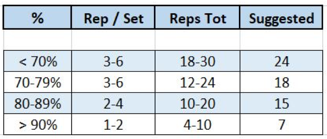How many times did you ask yourself if you were doing the right amount of reps at a given load?
Often, athletes without a coach make the mistake of doing too many total reps, or too little at a certain percentage of their training max.
Prilepin’s table can give coaches and athletes a great help by giving us ranges of reps for a given load, and how many total reps we should do.

Naim Suleymanoglu, considered one of the greatest weightlifters of all time.
What is Prilepin’s Table?
It was created many years ago by Alexander Sergei Prilepin, who recorded and studied data off of the best Olympic weightlifters.
It is a great way to program weightlifting training, but it can also be used in Strength & Conditioning for both strength and power training, and by powerlifters. What we do have to keep in mind is that squats, bench, and deadlifts are very different from the snatch and the clean & jerk.
So they should be treated differently. However, Prilepin’s table can still be used as a guideline for the big 3.
Often I get asked if bodybuilders should keep an eye on Prilepin’s table, and the answer is: no, they should not.
In weightlifting, you want to exert maximum power, in powerlifting maximum strength at every rep. Bodybuilding looks for mechanical tension, muscular fatigue, and metabolic stress.

How to read Prilepin’s Table
- The first column shows the % of 1RM
- The second, the reps per set for the given load
- The third, the suggested rep range
- The fourth, the suggested total reps
So how do we know if we are working too much, or too little, in a given session?
If we do fewer reps than suggested at a given load, we are not stimulating growth. If we do more than the suggested reps at a given weight, we risk overuse injury and accumulating too much fatigue.
Does this mean we can never use more or fewer reps than recommended?
Of course not: we can use fewer reps as light or recovery session or during a deload week. We can use more reps than suggested for a hefty session or in a shock microcycle.
However, we should respect, in general, the suggested volume x load in a single session.
Prilepin’s Table limits
The numbers only speak for a single session: what about frequency and volume per week?
Squats, bench, and deadlift are different beasts and stress our system in very different ways: we should not treat them as equals.
It does not take into consideration the individual: a small woman can handle lots more volume for the bench press than a heavy man, for example.

Setanta College Olympic Weight Lifting Masterclass
My reflections
The first time I read about Prilepin’s table, I thought my job as a Strength Coach was going to become so much easier.
Turns out, as good as it can be having these numbers in mind, this table has many limitations for the big 3 and strength training in general.
It was never intended for powerlifting or sports athletes in the first place.
At the same time, I am 100% confident that we can do much worse than prescribing volume and load using Prilepin’s table.
Most inexperienced strength coaches, I believe, should use it daily and memorize it.
Often, I feel like the table is a little too easy on the athlete for the bench press and overhead press (Yes, you can use it for the OHP), decent for the squat, and useful for the deadlift, which is very taxing for the central nervous system.
Many powerlifting coaches still use Prilepin’s table today for programming: from Boris Sheiko to Louie Simmons.
In 2016, a study that used Prilepin’s table was published.
Subjects trained the squat, bench, and deadlift for four weeks using a linear progression based on the table.
All subjects got stronger.
Unfortunately, subjects were not strong in the first place, and we all know that if intensity, frequency, and volume are correctly programmed, it is harder not to get stronger for a novice.
Note: the bench was the lift that increased less.
I am a firm believer that we cannot treat the bench press as we address the squat and deadlift.
The bench press can handle much more volume at much higher average intensity, than both the squat and the deadlift.
Conclusion
I always keep in mind Prilepin’s table when I design programs for my athletes. I think it is essential to know it well, to know it’s strengths and limitations, and to use it when needed.
If decades later, we are still here talking about Prilepin’s table and his data, and using it daily, we can say that it stood the test of time.
Learn more about the courses available at Setanta College here, or contact a member of our team below.
Contact form
Article References:
Pritchar, H., Barnes, M., Keogh, J., & McGuigan, M. (2016). The effectiveness of Prilepin’s chart for powerlifting strength improvements in resistance-trained males. NSCA 2016 National Conference. New Orleans: National Strength and Conditioning Association, (July), 7–8.



Leave A Comment